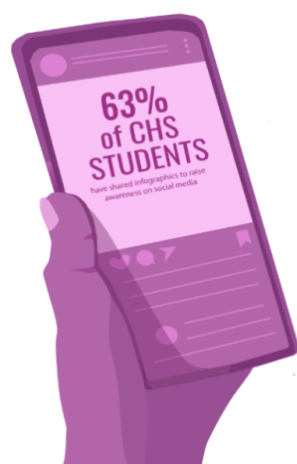Infographics are new controversial tool for spreading awareness

BLOT GRAPHICS BY Z. SABRINA LIDING, CINDY LIN, and JANELL GUI
Survey of 54 CHS students from Dec. 6 to Dec. 16.
January 20, 2023
Throughout the past decade, activism against social injustices and racial discrimination have increased, and social media has become a primary outlet to share this content.
From Black Lives Matter to March For Our Lives, multiple organizations found a way to have their messages were heard through protests and other public outcries.
The social change began to expand further than in-person events and quickly spread through digital media platforms. Amidst Gofundme links and change.org petitions, a social phenomenon that is common amongst all users is infographics.
Infographics are user-made posts that offer information about specific topics, commonly displaying phrases like “stop scrolling if you care about human rights” and “things you should care about.” Although many believe infographics bring awareness to current events, other users also acknowledge the harmful effects that stem from them.
Junior Alex Batzar of Middletown believes creating infographics is a quick way to gain views or followers and isn’t always a trustworthy source.
“A lot of the time, you don’t know who is behind a social media account posting the graphics and it could be someone trying to spread false information,” Batzar said.
A popular Instagram account, @feminist, reached over five million followers by spreading and essentially, plagiarizing content made by other activists, artists and politicians who are often people from marginalized communities. It was found that @feminist and other progressive accounts, like @chnge and @march, are run by two white men – Jacob Castaldi and Tanner Sweitzer.
According to an intersectional feminist organization and website, The Revival Zine, @chnge sells merchandise and donates only 50% of their net profit to charitable organizations and about $200,000 to the Black Lives Matter movement.
After Castaldi and Sweitzer received negative feedback for their little involvement in these causes, other outlets inspiring social change have spoken out against the dangers of infographics and how normalizing this behavior actively harms marginalized communities.
According to the digital media and entertainment website Refinery29, infographics are meant to educate their audience and inspire them to take action. However, they instead encourage performative activism, or ‘slacktivism,’ by allowing people to feel fulfilled simply by reading the information and hitting the repost button.
Furthermore, infographics have switched from being constructed by activists and researchers, often people of color, to now anonymous and elusive users.
Infographics continue to be posted by Instagram users today, though the topic remains controversial when discussing performative activism.
Junior Justin Longo of Middletown believes infographics are incapable of telling the full story within the commonly used format of a three-slide Instagram post.
“I think that most of the time infographics dangerously oversimplify topics that require a great deal of nuance, which can be damaging to the causes being promoted,” Longo said.




